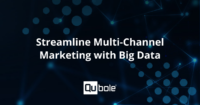Customer segmentation is nothing new to an experienced marketer. Traditional B2C segments based on demographic, psychographic, and behavioral data are taught in introductory college courses, and B2B marketers are well familiar with segments based on company size or purchase criteria. While these segments have served as a useful guide for decades, the era of big data has created segmentation 2.0. Thanks to a multitude of new data types and improved customer segmentation analysis, we are learning even greater, more granular details about audiences everywhere.
With data collected via social media, mobile, and other online interactions, marketers can further narrow these customer segments. These smaller groups, or micro-segments, allow marketers to create more tailored and targeted content, offers, products, and services. The more direct and customized an approach is, the higher its potential for real and substantial returns. And while the benefits make sense, it can be difficult to understand how to use big data to further the goals and objectives of your organization. Fortunately, creativity is contagious, and we can learn a lot from the efforts of others. Here are a couple of examples from companies making good use of big data for micro-segmentation.
Time Warner
Time Warner, a massive media company, has millions of customers. Not surprisingly, they collect information on each and every one of them. As a result, they are gathering 0.6 terabytes of data a day. This information has allowed them to create personalized advertising and tailored campaigns for their customers.
Time Warner combines demographic data sets and local viewing habits with other data, like real estate records and voter registration. This helps Time Warner understand their customers on a more individualistic level, with insights into income, local environment, and political preferences. From there, Time Warner can create and push their campaigns and ads using multiple mediums, like mobile apps, social media, their website, and television. This in turn provides more information on how people respond on each of these platforms, and Time Warner can make adjustments and corrections to further customize future ads.
Amazon
If you have a moment, head over to Amazon.com. What items are they recommending that you buy? They’re probably different than what the person next to you would see. But how do they do it? Amazon creates a site unique to each customer. Every time you sign in to your account, browse items or make purchases Amazon takes note. Then, the next time you return, they’ll offer you similar items based on your history.
Amazon even takes things a step further. By collecting information on all of its users, it recognizes trends in people who make similar purchases. For example, if more than 80 percent of people who buy a pair of running shoes also buy a fitness band, you’ll be offered a fitness band with your next shoe purchase. By offering people more of what they want, even if they weren’t specifically searching for it, they’re more likely to make additional purchases.
The big picture?
In the early days of advertising, marketers didn’t have the huge amounts of information we do today. They didn’t have our tools either. It might seem a little overwhelming, but once mastered, customer segmentation analysis will lead to more tailored messaging and effective strategies. Take the time to understand what data is important to your organization, how you will collect and store it, and finally, invest in the right tools to ensure success with your big data project.






